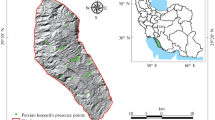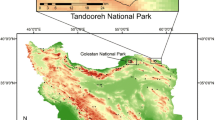Abstract
The conservation of top predators’ habitats such as the leopard (Panthera pardus) is one of the most effective ways to conserve biodiversity because of wide home range and habitat requirements. Accordingly, in this study, we used species’ habitat suitability modeling to survey the current and future habitat suitability of the Persian leopard in Iran. Sixty-two change scenarios (CC scenarios) (by 19 global climate models under four representative concentration pathways) were used to model future habitat suitability of the Persian leopard in Iran by MaxEnt model. Our results showed that prey availability is a key habitat variable to predict habitat suitability for leopard, and Capra aegagrus is the most important prey for this species in Iran. So, the distribution of Capra aegagrus plays an important role to model habitat suitability of the Persian leopard in Iran. The results also showed that 63% of the current suitable habitats will be decreased over 63 years. The results also showed a considerable change of suitable habitats which can threat long-term survival of this species in Iran. Our results revealed that one of the most important threats for the Persian leopard in future is changing suitable habitat due to climate change. Therefore, identifying and protecting potential habitats and minimizing human activities within areas are essential for current and future conservation.



Similar content being viewed by others
References
Athreya V, Odden M, Linnell JD, Karanth KU (2011) Translocation as a tool for mitigating conflict with leopards in human-dominated landscapes of India. Conserv Biol 25(1):133–141
Beaumont LJ, Hughes L, Poulsen M (2005) Predicting species distributions: use of climatic parameters in BIOCLIM and its impact on predictions of species’ current and future distributions. Ecol Model 186(2):251–270
Carbone C, Gittleman JL (2002) A common rule for the scaling of carnivore density. Science 295(5563):2273–2276
Change IPOC (2014) IPCC. Climate change
Datta A, Anand MO, Naniwadekar R (2008) Empty forests: large carnivore and prey abundance in Namdapha National Park, north-east India. Biol Conserv 141(5):1429–1435
Elith J, Leathwick JR (2009) Species distribution models: ecological explanation and prediction across space and time. Annu Rev Ecol Evol Syst 40:677–697
Elith J, Phillips SJ, Hastie T, Dudík M, Chee YE, Yates CJ (2011) A statistical explanation of MaxEnt for ecologists. Divers Distrib 17(1):43–57
Engler R, Guisan A, Rechsteiner L (2004) An improved approach for predicting the distribution of rare and endangered species from occurrence and pseudo-absence data. J Appl Ecol 41(2):263–274
Erfanian B, Mirkarimi SH, Mahini AS, Rezaei HR (2013) A presence-only habitat suitability model for Persian leopard Panthera pardus saxicolor in Golestan National Park, Iran. Wildl Biol 19(2):170–178
Farhadinia MS, Moqanaki EM, Hosseini-Zavarei F (2014) Predator–prey relationships in a middle Asian Montane steppe: Persian leopard versus urial wild sheep in Northeastern Iran. Eur J Wildl Res 60(2):341–349
Farhadinia MS, Ahmadi M, Sharbafi E, Khosravi S, Alinezhad H, Macdonald DW (2015a) Leveraging trans-boundary conservation partnerships: persistence of Persian leopard (Panthera pardus saxicolor) in the Iranian Caucasus. Biol Conserv 191:770–778
Farhadinia MS, Farahmand H, Gavashelishvili A, Kaboli M, Karami M, Khalili B, Montazamy S (2015b) Molecular and craniological analysis of leopard, Panthera pardus (Carnivora: Felidae) in Iran: support for a monophyletic clade in Western Asia. Biol J Linn Soc 114(4):721–736
Feeley KJ, Silman MR (2010) Modelling the responses of Andean and Amazonian plant species to climate change: the effects of georeferencing errors and the importance of data filtering. J Biogeogr 37(4):733–740
Fielding AH, Bell JF (1997) A review of methods for the assessment of prediction errors in conservation presence/absence models. Environ Conserv 24(1):38–49
Garden JG, O’Donnell T, Catterall CP (2015) Changing habitat areas and static reserves: challenges to species protection under climate change. Landsc Ecol 30(10):1959–1973
Gavashelishvili A, Lukarevskiy V (2008) Modelling the habitat requirements of leopard Panthera pardus in west and central Asia. J Appl Ecol 45(2):579–588
Ghoddousi A, Hamidi AK, Ghadirian T, Ashayeri D, Khorozyan I (2010) The status of the endangered Persian leopard Panthera pardus saxicolor in Bamu National Park, Iran. Oryx 44(4):551–557
Grayson DK (2000) Mammalian responses to Middle Holocene climatic change in the Great Basin of the western United States. J Biogeogr 27(1):181–192
Guisan A, Thuiller W (2005) Predicting species distribution: offering more than simple habitat models. Ecol Lett 8(9):993–1009
Guisan A, Zimmermann NE (2000) Predictive habitat distribution models in ecology. Ecol Model 135(2):147–186
Hayward MW, O’Brien J, Kerley GI (2007) Carrying capacity of large African predators: predictions and tests. Biol Conserv 139(1):219–229
Hegel TM, Cushman SA, Evans J, Huettmann F (2010) Current state of the art for statistical modelling of species distributions. In: Cushman SA, Huettmann F (eds) Spatial complexity, informatics, and wildlife conservation. Springer, New York, pp 273–311
Hebblewhite M, Miquelle DG, Murzin AA, Aramilev VV, Pikunov DG (2011) Predicting potential habitat and population size for reintroduction of the Far Eastern leopards in the Russian Far East. Biol Conserv 144(10):2403–2413
Hiestand SJ, Nielsen CK, Jiménez FA (2014) Modelling potential presence of metazoan endoparasites of bobcats (Lynx rufus) using verified records. Folia Parasitol 61:401–410
IUCN Standards and Petitions Subcommittee (2016) Guidelines for using the IUCN red list categories and criteria version 2. Prepared by the Standards and Petitions Subcommittee. http://cmsdocs.s3.amazonaws.com/RedListGuidelines.pdf
Iverson LR, McKenzie D (2013) Tree-species range shifts in a changing climate: detecting, modeling, assisting. Landsc Ecol 28(5):879–889
Jacobson AP, Gerngross P, Lemeris JR Jr, Schoonover RF, Anco C, Breitenmoser-Würsten C, Laguardia A (2016) Leopard (Panthera pardus) status, distribution, and the research efforts across its range. PeerJ 4:e1974
Jowkar H, Ostrowski S, Tahbaz M, Zahler P (2016) The conservation of biodiversity in Iran: threats, challenges and hopes. Iran Stud 49(6):1065–1077
Karami M, Ghadirian T, Faizolahi K (2015) The atlas of the mammals of Iran. Iran Department of the Environment, Tehran
Khanum R, Mumtaz AS, Kumar S (2013) Predicting impacts of climate change on medicinal asclepiads of Pakistan using Maxent modeling. Acta Oecol 49:23–31
Khorozyan IG, Abramov AV (2007) The Leopard, Panthera pardus, (Carnivora: Felidae) and its resilience to human pressure in the Caucasus. Zool Middle East 41(1):11–24
Khorozyan I, Malkhasyan A, Asmaryan S (2005) The Persian leopard prowls its way to survival. Endanger Species Update 22(2):51
Kiabi BH, Dareshouri BF, Ghaemi RA, Jahanshahi M (2002) Population status of the Persian leopard (Panthera pardus saxicolor Pocock, 1927) in Iran. Zool Middle East 26(1):41–47
Kumar S, Stohlgren TJ (2009) Maxent modeling for predicting suitable habitat for threatened and endangered tree Canacomyrica monticola in New Caledonia. J Ecol Nat Environ 1(4):94–98
Levinsky I, Skov F, Svenning JC, Rahbek C (2007) Potential impacts of climate change on the distributions and diversity patterns of European mammals. Biodivers Conserv 16(13):3803–3816
Liang CT, Stohlgren TJ (2011) Habitat suitability of patch types: a case study of the Yosemite toad. Front Earth Sci 5:217–228
Liang CT, Grasso RL, Nelson-Paul JJ, Vincent KE, Lind AJ (2017) Fine-scale habitat characteristics related to occupancy of the Yosemite toad, Anaxyrus canorus. Copeia 105(1):120–127
Millennium Ecosystem Assessment (2005) Ecosystems and human wellbeing: a framework for assessment. Island Press, Washington
Meinshausen M, Smith SJ, Calvin K, Daniel JS, Kainuma MLT, Lamarque JF, Thomson AGJMV (2011) The RCP greenhouse gas concentrations and their extensions from 1765 to 2300. Clim Change 109(1–2):213
Morán-Ordóñez A, Lahoz-Monfort JJ, Elith J, Wintle BA (2017) Evaluating 318 continental-scale species distribution models over a 60-year prediction horizon: what factors influence the reliability of predictions? Glob Ecol Biogeogr 26(3):371–384
Morueta-Holme N, Fløjgaard C, Svenning JC (2010) Climate change risks and conservation implications for a threatened small-range mammal species. PLoS ONE 5(4):e10360
Negga HE (2007) Predictive modelling of amphibian distribution using ecological survey data: a case study of Central Portugal. ITC
Pacifici M, Foden WB, Visconti P, Watson JE, Butchart SH, Kovacs KM, Corlett RT (2015) Assessing species vulnerability to climate change. Nat Clim Change 5(3):215
Packer C, Brink H, Kissui BM, Maliti H, Kushnir H, Caro T (2011) Effects of trophy hunting on lion and leopard populations in Tanzania. Conserv Biol 25(1):142–153
Peterson AT, Radocy T, Hall E, Peterhans JCK, Celesia GG (2014) The potential distribution of the Vulnerable African lion Panthera leo in the face of changing global climate. Oryx 48(4):555–564
Phillips SJ (2008) Transferability, sample selection bias and background data in presence-only modelling: a response to Peterson et al. (2007). Ecography 31(2):272–278
Phillips SJ, Anderson RP, Schapire RE (2006) Maximum entropy modeling of species geographic distributions. Ecol Model 190(3):231–259
Raza RH, Chauhan DS, Pasha MKS, Sinha S (2012) Illuminating the blind spot: a study on illegal trade in leopard parts in India (2001–2010). TRAFFIC India/WWF India, New Delhi
Rogelj J (2013) Long-term climate change: projections, commitments and irreversibility. In: Climate change 2013: the physical science basis. IPCC working group I contribution to AR5—the physical science basis. IPCC working group I contribution to AR5, Cambridge University Press, Cambridge UK and New York, USA, pp 1029–1136
Rooper CN, Sigler MF, Goddard P, Malecha P, Towler R, Williams K, Zimmermann M (2016) Validation and improvement of species distribution models for structure-forming invertebrates in the eastern Bering Sea with an independent survey. Mar Ecol Prog Ser 551:117–130
Sanei A, Zakaria M (2011) Distribution pattern of the Persian leopard (Panthera pardus saxicolor) in Iran. Asia Life Sci Suppl 7:7–18
Swanepoel LH, Somers MJ, van Hoven W, Schiess-Meier M, Owen C, Snyman A, Dalerum F (2015) Survival rates and causes of mortality of leopards Panthera pardus in southern Africa. Oryx 49(4):595–603
Swets JA (1988) Measuring the accuracy of diagnostic systems. Science 240(4857):1285–1293
Taghdisi M, Mohammadi A, Nourani E, Shokri S, Rezaei A, Kaboli M (2013) Diet and habitat use of the endangered Persian leopard (Panthera pardus saxicolor) in northeastern Iran. Turk J Zool 37(5):554–561
Thorn JS, Nijman V, Smith D, Nekaris KAI (2009) Ecological niche modelling as a technique for assessing threats and setting conservation priorities for Asian slow lorises (Primates: Nycticebus). Divers Distrib 15(2):289–298
Uphyrkina O, Johnson WE, Quigley H, Miquelle D, Marker L, Bush M, O’Brien SJ (2001) Phylogenetics, genome diversity and origin of modern leopard, Panthera pardus. Mol Ecol 10(11):2617–2633
Valeix M, Loveridge AJ, Davidson Z, Madzikanda H, Fritz H, Macdonald DW (2010) How key habitat features influence large terrestrial carnivore movements: waterholes and African lions in a semi-arid savanna of north-western Zimbabwe. Landsc Ecol 25(3):337–351
Waltari E, Guralnick RP (2009) Ecological niche modelling of montane mammals in the Great Basin, North America: examining past and present connectivity of species across basins and ranges. J Biogeogr 36(1):148–161
Author information
Authors and Affiliations
Corresponding author
Rights and permissions
About this article
Cite this article
Ebrahimi, A., Farashi, A. & Rashki, A. Habitat suitability of Persian leopard (Panthera pardus saxicolor) in Iran in future. Environ Earth Sci 76, 697 (2017). https://doi.org/10.1007/s12665-017-7040-8
Received:
Accepted:
Published:
DOI: https://doi.org/10.1007/s12665-017-7040-8




